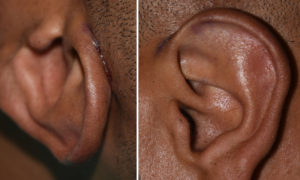Background: The most commonly performed aesthetic ear procedure (not including the repair of earlobe tears) is a s setback otoplasty. Done for correction of the protruding ears, various cartilage manipulations are done on the back of the ear to bend the cartilage and move the ear inward so its protrusion from the side of the head is decreased. While the setback otoplasty is done to what looks more aesthetically pleasing, it is decreasing the auriculocephalic angle to a more normal measurement.
The normal measurement of the auriculocephalic angle, or how much the ear protrudes from the side of the head, is traditionally in the 15 to 25 degree range. But this traditional measurement comes from men and women that have hair. in the shaved male head, the ear that has a normal auriculocephalic angle bmay be considered excessive without the buffering of the surrounding hair. But in the spirit of the shaved head, where a sleek and smooth appearance is the overall goal, a normal amount of ear protrusion may be aesthetically excessive.
While traditional cartilage suturing methods work well for the abnormally protruding ear, they may not work as well to set back an ear that does not have an exaggerated auriculocephalic angle.


The auriculocephalic sulcus is a normal anatomic structure that exists to separate the ear form the side of the head. This has relevance for eyeglass wear and the normal flexibility of the ear. But in special circumstances for certain aesthetic needs and, in particular the shaved male head, the normal relationship of the ear to the side of the head may be different than in the person who has hair. In these situation the diminution or the obliteration of the auriculocephalic sulcus may be necessary to achieve the desired aesthetic result.
Highlights:
1) The protruding ear in the shaved male head may be a lot less than what would be considered excessive by traditional auriculocephalic measurements.
2) Trying to bend the upper helical rim in by suturing otoplasty methods to bend the cartilage will often fail.
3) To maximally move the upper helical rim inward the postauriuclar sulcus must be eliminated and the cartilage sutured to the temporalis fascia for a unique otoplasty method.
Dr. Barry Eppley
Indianapolis, Indiana


